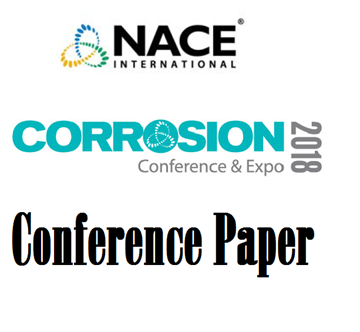Wet gas corrosion rates of C1018 steel at the top and bottom of a high pressure 10 cm diameter horizontal pipeline have been measured under annular flow conditions at 0.45 MPa CO2 and 90°C. The corrosive medium consists of de-ionized water and a low viscosity hydrocarbon phase at water cuts of 80%. Superficial gas velocities (Vsg) of 15 and 20 m/s were applied at a superficial liquid velocity (Vsl) of 0.05 m/s for 100 hours. The instantaneous corrosion rates measured by electrical resistance (ER) technique advance in three stages showing an exponential decay corresponding to the iron carbonate scale forming process. The general corrosion rates measured by ER are low, which are also confirmed by the coupon weight loss measurements of average corrosion rates. No flow induced localized corrosion (FILC) was found for the flow and corrosion conditions applied. Surface analysis techniques
such as scanning electron microscopy (SEM) and X-ray photoelectron spectroscopy (XPS) revealed that the iron carbonate film forming process is flow dependent and different for scales formed on the top and on the bottom of the pipe, resulting in different crystal sizes. Cross-sectional analysis by use of metallurgical microscope (MM) indicates that a low thickness of the corrosion product film, usually less than 10 microns, is responsible for the high protectivity of the scales formed under these conditions.
Key words: C1018 steel, wet gas, CO2 corrosion, annular flow, corrosion rate, morphology, iron carbonate film, cross section, surface analysis




